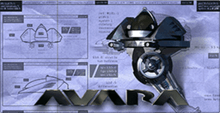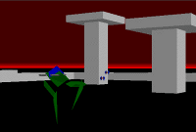Avara
Avara is a 1996 first-person shooter written by Juri Munkki for Macintosh and published by Ambrosia Software.[1] A fast 3D engine, integrated Internet play, and easy level editing were notable features at the time of its release. While not commercially successful, the game found a cult following. Munkki publicly released the source code in 2016, the game's 20th anniversary.[3]
| Avara | |
|---|---|
 | |
| Publisher(s) | Ambrosia Software |
| Designer(s) | Juri Munkki |
| Artist(s) | Matthew Schroeder Joe Raffa |
| Platform(s) | Classic Mac OS |
| Release |
|
| Genre(s) | First-person shooter |
| Mode(s) | Single player, Multi-player |
Gameplay

Players operated a remote-controlled bipedal robot known as a Hostile Environment Combat and Tactical Operations Remote, or HECTOR.[4] The unit's characteristics were customizable, ranging in mass from 150 to 220 kilograms (330 to 490 lb), and stood about 2 meters (7 ft) tall. Larger models could hold more weaponry, useful in the game's primary mode as a shooter, but were less maneuverable in combat.[4] The name HECTOR represents a thinly-guised tribute to Hector D. Byrd, Ambrosia's mascot, a female grey parrot.[5]
Flying scout units controlled by each player provided an aerial view of the action, but were defenseless and could be destroyed by enemies or other HECTORs. Up to 6 players could join a game at once, either free-for-all, or in arbitrary teams which were chosen by color. Team color choice also affected the in-game HECTOR model's appearance. During games, players could communicate using an integrated text-based chat system.[6]
Level maps for the engine's fully 3D world could be created using user-friendly, vector-based drawing programs such as ClarisWorks, ClarisDraw, or ShareDraw.[7] Avara was bundled with some of these level packs, both for solo play and multiplayer modes, and fan-created packs were available for download from Ambrosia's website.[8]
Development
Juri Munkki, the designer, had been interested in 3D graphics ever since the Apple II, but the machine lacked the horsepower to do what he wanted. When Hellcats was released and he saw that fast polygon rendering was possible on Mac. Seeing that it could be done, Juri had another go at writing his own polygon rendering library in late 1992 and this time came up with an early version of what's used in Avara.
This animation library was strictly 2D. Although he was doing some 3D work at the time, it was just wireframe graphics. He used the polygon library to write a very different kind of sprite animation: the sprites were actually polygons that you could transform (scale, rotate, distort) freely.
In May 1994, Juri was at Apple's Worldwide Developers Conference for the first time. Since it was polygon graphics and the objects were zooming up and down very quickly on the screen, people tended to assume he was doing very fast 3D graphics. He wanted to show the technology to a gaming evangelist and was readying the demos on a PowerBook in the main hall at the San Jose Convention Centre when Stuart Cheshire (the author of Bolo for Macintosh) happened to sit right behind him and see what Juri was doing. Stuart started talking to Juri and said he would really like to see a real 3D version of this technology for use in a 3D version of Bolo. Juri says he thinks he told him that he would keep in touch if anything came from it. He never met the games evangelist - he didn't show up to the meeting.
A bit later Juri corresponded with Christian Fanz who was working on an Elite style game for Macintosh. He was having difficulty getting the 3D graphics fast enough and, remembering his chat with Stuart, Juri took the challenge and had some fun implementing a BSP library.
Both Stuart and Christian seemed impressed with the demo. Juri made some spaceship models as samples and wrote a few demos to show how the library was used. One of the demos allowed you to drive around scenery. The idea was to verify that the objects were all being sorted into correct visual order. It would be from this experimental stress test that Avara would be born.
For a long time, Juri had wanted to do a battlezone style game where the turret could move freely, so he thought he would spend a few weeks before Christmas writing a simple networked game/demo where you had tanks with freely moving turrets. He thought it might be fun to let the game evolve by letting other shareware/freeware authors work on it too, so he posted an article about it on comp.sys.mac.games. Andrew Welch saw the article and that's how the game became an Ambrosia title.
The walking robot was implemented a bit later, but HECTOR didn't have a name until much later and it couldn't jump (just walked). The jumping came a year later, when Juri thought he had the game ready for release, except for the tiny detail of needing a bunch of levels to play with. The idea for a walking and jumping robot slightly predates the engine: Juri had some early sketches of that, in addition to the actual walking animation code from 1992. It just wasn't something he originally intended to be in the game.
Andrew spent a lot of time playing Bolo, so he insisted on having internet play. Juri was pretty much convinced the program architecture and game were not suitable for internet play, but eventually took the challenge in January 1996 and wrote something that "kinda" worked on the internet.
Encouraged by this, Juri kept working on the internet code, and got it to a point where he could reasonably play a game from Finland to the USA (modem to modem).
Andrew and Juri managed to get a bunch of reasonably interesting levels together, and then released Avara 1.0.0.
Juri was pretty active in the first week or two when Avara was released, but had to switch to a new ISP (for reasons unrelated to Avara) at about that time. Unfortunately the connections from that ISP were totally inadequate for Avara, so he couldn't play anymore. He has to admit, however, that after two years of playing the game every single day, he was pretty tired of it too.
Reception
Avara was a commercial flop. At the time, it was Ambrosia's poorest selling game next to Chiral.
Legacy
In 2017, Munkki posted the source to his GitHub account, under the MIT software license.[3] In September 2018, a fan-made port of Avara was posted on GitHub. It claims to run on recent versions of Windows, Mac OS, and Linux.
References
- "Ambrosia Software Releases Avara: Survival in 3D Geometric Jungles". Retrieved 2007-11-17.
- "Avara (Game) - Giant Bomb". Giant Bomb. Retrieved 2019-05-07.
- Juri Munkki (2016-10-30). "Avara game, originally released in 1996 for Mac OS". Retrieved 2016-10-30.
- Munkki, Juri (1996-07-01). "Ambrosia Times: The H.E.C.T.O.R." Ambrosia Software. Retrieved 2013-01-14.
- "About Us | Ambrosia Software, Inc". Ambrosia Software. Archived from the original on 2015-12-16. Retrieved 2013-01-14.
- "Ambrosia Times: Avara Preview 1". Ambrosia Software. Retrieved 2013-07-16.
- "Avara (Juri Munkki)". Juri Munkki. Retrieved 2013-01-14.
- "Add-on Files | Ambrosia Software, Inc". Ambrosia Software. Retrieved 2013-01-14.
External links
- Juri Munkki (Designer's website)
- Source code for Avara on GitHub